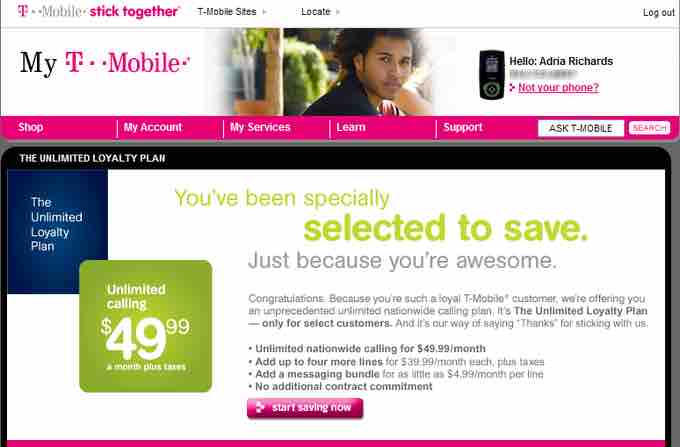The Many Goals of Persuasion
To convince consumers that their products possess advantages over similar brands, companies focus on differentiating their brands using various promotional tactics. Advertising, personal selling, sales promotion, and public relations activities are commonly used to persuade consumers to make a purchase. Brands constantly promote product features and benefits to convince consumers that their products either address the consumer's needs or solve a particular problem. By promoting their brand in creative and compelling ways, companies hope to create positive esteem and loyalty toward the brand to fuel repeat purchases and customer retention.

T-Mobile Promotion
Companies such as T-Mobile use special promotions to drive repeat business and brand loyalty.
Product Differentiation
When running promotional programs, companies seek to clearly and effectively market their product's differential factor. Differentiation sets similar products apart from one another, and creates value for consumers evaluating different brands. Differentiating products allows companies to influence consumers' perception of their brand in an increasingly crowded marketplace. If the product's differential factor is compelling enough, companies hope to convince consumers to continually choose their products over competitors.
Companies employ a myriad of techniques to shape consumers' perception of the physical products displayed in stores or on the street. Common persuasive techniques include:
- Using bright and attractive displays depicting emotions such as excitement, relaxation, or happiness.
- Incorporating prominent and easily recognizable colors in billboards, print ads, and design packaging.
- Strategically placing and arranging products in stores to allow for maximum visibility and purchase opportunities.
Colors and imagery can serve as powerful visuals for quickly conveying a product's ability to successfully meet consumer needs. For instance, colors such as yellow and orange provoke excitement while blue and green establish trust, cleanliness, and calmness. As more consumers spend their time surfing the Internet on computers and mobile devices, similar strategies are used in online promotions such as banner ads and email communications. Digital communications, like traditional communications, rely on captivating and clever messaging to prompt open rates and click-throughs to advertisers' landing pages. With social media, companies have the ability to advertise their product's differential qualities to any person in the world, at any given instant.
Brand Awareness and Loyalty
The primary objective of marketers and advertisers is to present ideas in a manner that is so convincing that consumers will not just purchase a product or service once, but will do so repeatedly over time. Companies must thus remind customers of their product's unique benefits using messaging that resonates with consumer needs and values. Branding, product marketing, and loyalty marketing all form part of the customer proposition – the subjective assessment by the customer on whether to purchase a brand based on the value they receive from each of these marketing elements.
As companies compete for consumer attention across print, television, radio, and the Internet, promotional tools such as reward and discount programs are repeatedly offered to loyal customers in return for their continued business. The airline industry's frequent flyer program is a successful example of loyalty marketing. These programs rely on the earned loyalty of current customers to attract new loyalty from future customers. However, exclusive incentive programs must strike a balance between increasing benefits for new customers over any existing loyalty plan they are currently in and keeping existing customers from moving to new plans.
Consumer Education
Companies look to be brand leaders in their industry by providing consumers with relevant information on product pricing, functionality, and availability. Providing consumers and other brand stakeholders with the skills, concepts, and understanding required to achieve maximum satisfaction and utilization of the product can transform consumer needs into perceived wants. Even after a purchase is made, companies devote sales and customer service teams to supporting customers with training and other educational programs. This idea is especially true for highly technical products such as computer software, which regularly release upgrades and new features.
Reviews of products in trade publications and on websites can also help promote or downgrade products. Consumers may include review and rating websites such as yelp.com or consumer reports as part of their education on product features and benefits. These reviews also serve as indirect public relations for the brand, potentially enhancing and strengthening brand value. Outside consumer opinions and expert insight fall under the arsenal of promotional tools that can persuade consumers during the buying decision process.